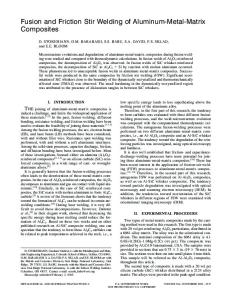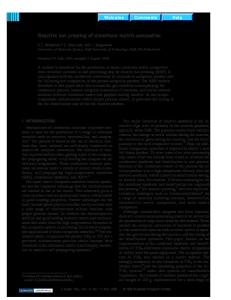Fabrication and characterization of aluminum matrix fly ash cenosphere composites using different stir casting routes
- PDF / 422,453 Bytes
- 7 Pages / 584.957 x 782.986 pts Page_size
- 11 Downloads / 346 Views
zhe Lyu School of Materials Science and Engineering, Zhengzhou University, Zhengzhou 450002, People’s Republic of China; and Department of Machine Design, Royal Institute of Technology, Stockholm SE-10044, Sweden
Airong Jiang and Jingyu Zhao School of Materials Science and Engineering, Zhengzhou University, Zhengzhou 450002, People’s Republic of China (Received 17 September 2013; accepted 19 November 2013)
Aluminum matrix fly ash (AMFA) cenosphere composites were fabricated using the stir casting technique. The used type of fly ash cenosphere, which accounted for over 60% in all fly ash particles, was in narrow and small size (2–30 lm). During synthesis, effects of several key technological parameters on microstructure and properties were investigated using orthogonal experimental design. The optimal technological parameter was achieved as: melt temperature of 700 °C 1 stirring rate of 1200 r/min 1 stirring time of 6 min 1 fly ash cenosphere content of 13 wt%. With this optimal technological parameter, as-cast and forged composites were manufactured. Their tensile strengths were measured and improved maximally by 50% when the cenosphere content is 13 wt%. Such size and content of fly ash cenosphere and technological parameter could largely improve the properties of composites, which should be introduced into the production process of AMFA composites.
I. INTRODUCTION
With continuous consumption of natural resources and energy sources apace, lightweight becomes increasingly valued and attractive to all aspects of human society.1 Accordingly, light metals and alloys including aluminum, magnesium, titanium etc. are incrementally used as structural materials instead of ferrous alloys and other heavy metals in automotive, aerospace, and military industries.2 However, these unreinforced light metals and alloys often failed to meet the requirements of components assembly. Therefore, some reinforcements and fillers in fiber and particulate forms are incorporated into these metals to obtain composite materials for improving the microstructure and properties. It is reported that the most efficient improvement in strength and stiffness properties is obtained with incorporation of fiber fillers,3 while anisotropy seriously hinders the widespread usage of this series of composites. The most usually considered particulate reinforcements such as SiC, A2 O3 , Si 2O3 , and graphite enable composites to overcome anisotropy. Yet, these composites are still in limited application in general industries due to the high production cost. Among the particulate a)
Address all correspondence to this author. e-mail: [email protected] DOI: 10.1557/jmr.2013.372 260
J. Mater. Res., Vol. 29, No. 2, Jan 28, 2014
http://journals.cambridge.org
Downloaded: 27 Apr 2015
reinforcements, the inexpensive fly ash (approximately 1/30 of SiC particles),1 a by-product generated during combustion of coal in thermal power plants, has been successfully incorporated into aluminum alloys as discontinuous dispersoids.4–6 There are two types of fly ash, namely, solid par
Data Loading...











